Copyright
This document is Copyright © 2020 by the LibreOffice Documentation Team. Contributors are listed below. You may distribute it and/or modify it under the terms of either the GNU General Public License (https://www.gnu.org/licenses/gpl.html), version 3 or later, or the Creative Commons Attribution License (https://creativecommons.org/licenses/by/4.0/), version 4.0 or later.
All trademarks within this guide belong to their legitimate owners.
Contributors
|
Jean Hollis Weber |
Kees Kriek |
Rafael Lima |
|
Jean Hollis Weber |
Toni Blackwelder |
Kees Kriek |
|
Shravani Bellapukonda |
Randolph Gamo |
Jenna Sargent |
|
Dante Legaspi |
Felipe Viggiano |
Pulkit Krishna |
|
Colleen Hayes |
John A Smith |
Peter Schofield |
|
Bruce Byfield |
Gillian Polack |
Cathy Crumbley |
|
Hazel Russman |
Leo Moons |
David Blymire |
|
Jeremy Cartwright |
John M. Długosz |
Barbara Duprey |
|
Jamie Eby |
Ron Faile Jr. |
Gary Schnabl |
|
Klaus-Jürgen Weghorn |
Rafael Atias |
|
Feedback
Please direct any comments or suggestions about this document to the Documentation Team’s mailing list: documentation@global.libreoffice.org
Note
Everything you send to a mailing list, including your email address and any other personal information that is written in the message, is publicly archived and cannot be deleted.
Publication date and software version
Published April 2021. Based on LibreOffice Community.
Other versions of LibreOffice may differ in appearance and functionality.
Introduction
This chapter covers the basics of working with text in Writer. It assumes that you are familiar with the use of a mouse and keyboard and that you have read about Writer’s menus and toolbars and other topics covered in Chapter 1, Introducing Writer.
We recommend that you also display formatting aids, such as end-of-paragraph marks, tabs, breaks, and other items in Tools > Options > LibreOffice Writer > Formatting Aids. You can hide or display these markers by going to View > Formatting Marks. See Chapter 20, Setting up Writer, for more information.
When you have read this chapter, you should know how to:
-
Select, cut, copy, paste, and move text.
-
Find and replace text.
-
Insert special characters.
-
Check spelling and grammar, use the thesaurus, and choose hyphenation options.
-
Use the AutoCorrect, Word Completion, AutoText, and case-changing features.
See also Chapter 3, Working with Text: Advanced, and Chapter 4, Formatting Text.
Selecting text
Selecting text in Writer is similar to selecting text in other applications. You can swipe the mouse cursor over text or use multiple clicks to select a word (double-click), sentence (triple-click), or paragraph (quadruple-click).
You can also click in the text, press F8 to enter Extending selection mode, and then use the arrow keys on your keyboard to select a contiguous block of text. Press F8 again after you have finished selecting the block of text.
In addition, you can select non-contiguous items and vertical blocks of text.
One way to change the selection mode is to use the icon on the Status bar (see Figure 1). When you right-click the icon, a context menu displays the available options: Standard selection, Extending selection (F8), Adding selection (Shift+F8), and Block selection (Ctrl+Shift+F8). Left-clicking cycles through these selections.
Figure 1: Changing the selection mode using the status bar

Selecting items that are not contiguous
To select non-contiguous items (as shown in Figure 2) using the mouse in Standard selection mode:
1) Select the first piece of text.
2) Hold down the Ctrl key and use the mouse to select the next piece of text.
3) Repeat as often as needed.
To select non-contiguous items using the keyboard in Adding selection mode:
1) Select the first piece of text. (For more information about keyboard selection of text, see the topic “Navigating and Selecting with the Keyboard” in the LibreOffice Help (F1).)
2) Press Shift+F8 to enable Adding selection mode.
3) Use the arrow keys to move to the start of the next piece of text to be selected. Hold down the Shift key and select the next piece of text.
4) Repeat as often as required.
Now you can work with the selected text. After finishing your work with the selected text, press Esc to exit Adding selection mode.
Figure 2: Selecting non-consecutive pieces of text

Selecting a vertical block of text
You can select a block text that spans through multiple rows using Writer’s Block selection mode. To change to Block selection mode, use Edit > Selection Mode > Block Area, or press Ctrl+F8, or click the Selection icon in the status bar and select Block selection in the list. Now you can highlight the selection, using mouse or keyboard, as shown in Figure 3.
Figure 3: Selecting a block of text

Cutting, copying, and pasting text
Cutting and copying text in Writer is similar to cutting and copying text in other applications. You can copy or move text within a document, or between documents, by dragging or by using menu selections, icons, or keyboard shortcuts. You can also copy text from other sources such as Web pages and paste it into a Writer document.
-
To move (drag and drop) selected text using the mouse, drag it to the new location and release it; the cursor changes shape while dragging.
-
To copy selected text, hold down the Ctrl key while dragging. The text retains the formatting it had before dragging.
-
To move (cut and paste) selected text, use Ctrl+X to cut the text, insert the cursor at the paste-in point and use Ctrl+V to paste. Alternatively, use the Copy/Paste buttons on the Standard toolbar.
When you paste text, the result depends on the source of the text and how you paste it. If you click the Paste button, then the pasted text keeps its original formatting (such as bold or italics). Text pasted from websites and other sources may be placed automatically into frames or tables as part of the format when you paste. If you do not like the results, click the Undo button or press Ctrl+Z.
To make the pasted text inherit the paragraph style at the insertion point:
-
Choose Edit > Paste Special, or
-
Click the arrow on the combination Paste button, or
-
Double-click the Paste button without releasing the left mouse button, or
-
Press Ctrl+Shift+V
Then select Unformatted text in the resulting menu.
You can also press Ctrl+Alt+Shift+V, which pastes unformatted text directly.
The range of choices on the Paste Special menu varies depending on the origin and formatting of the text (or other object) to be pasted. See Figure 4 for an example with text on the clipboard.
Figure 4: Paste Special menu
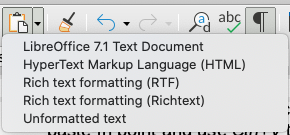
Finding and replacing text
Writer has two ways to find text within a document: the Find toolbar for fast searching and the Find & Replace dialog. In the dialog, you can:
-
Find and replace words and phrases.
-
Use wildcards and regular expressions to fine-tune a search (see Chapter 3).
-
Find and replace specific attributes or formatting (see Chapter 3).
-
Find and replace paragraph styles (see Chapter 3).
Using the Find toolbar
By default, the Find toolbar is shown docked at the bottom of the LibreOffice window (just above the Status Bar) in Figure 5, but you can float it or dock it in another location. For more information on floating and docking toolbars, see Chapter 1, Introducing Writer. If the Find toolbar is not visible, you can display it by choosing View > Toolbars > Find on the Menu bar or by pressing Ctrl+F.
Figure 5: Docked position of Find toolbar

To use the Find toolbar, click in the text input box and type your search text, then press Enter to find the next occurrence of that term from the current cursor position. Click the Find Next or Find Previous buttons as needed.
Click the Find All button to select all instances of the search term within the document. Select Match Case to find only the instances that exactly match the use of upper and lower case letters in the search term. Click the icon next to Match Case to open the Find and Replace dialog.
To close the Find toolbar, click the X button on the left, or press Esc on the keyboard when the text cursor is in the search box.
Using the Find and Replace dialog
To display the Find and Replace dialog (Figure 6), use any of the following methods:
-
Use the keyboard shortcut Ctrl+H,
-
Choose Edit > Find and Replace on the Menu bar.
-
Click the Find and Replace button on the Find toolbar. When the dialog is open, optionally click Other Options to expand it (see Figure 6).
Figure 6: Expanded Find & Replace dialog

To use the Find and Replace dialog:
1) Type the text you want to find in the Find box.
2) To replace the text with different text, type the new text in the Replace box.
3) You can select various options, such as matching the case or matching whole words only.
4) When you have set up the search, click Find Next. As the document view moves to each found instance, you can replace the text by clicking Replace or skip that instance by clicking Find Next again.
Tip
If you click Find All, Writer selects all instances of the search text in the document. Similarly, if you click Replace All, Writer replaces all matches, without stopping for you to accept each instance.
Caution
Use Replace All with caution; otherwise, you may end up with mistakes that you won’t be able to undo later on if you save and close the file. A mistake with Replace All might require a manual, word-by-word, search to fix. (Ctrl+Z works only before the file is saved.)
Inserting special characters
A special character is one not found on a basic English keyboard. For example, © ¾ æ ç Ł ñ ö ø ¢ are all special characters.
To insert one or more special characters, place the cursor in the position where you want the characters to appear. Then do one of the following:
-
Click the Special Character icon in the Standard toolbar to open a list of favorite and recently used characters and click on the one you wish to insert (see Figure 7). You can also open the Special Characters dialog (Figure 8) by clicking the More Characters button on this list.
Figure 7: Insert Special Characters in the standard toolbar
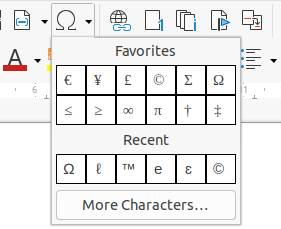
-
Click Insert > Special Character to open the Special Characters dialog (Figure 8). Double-click the characters (from any font or mixture of fonts) you wish to insert, in order; they appear in the document as you select them. The selected characters are also added to the Recent Characters list on the lower left of the dialog.
Figure 8: The Special Characters dialog
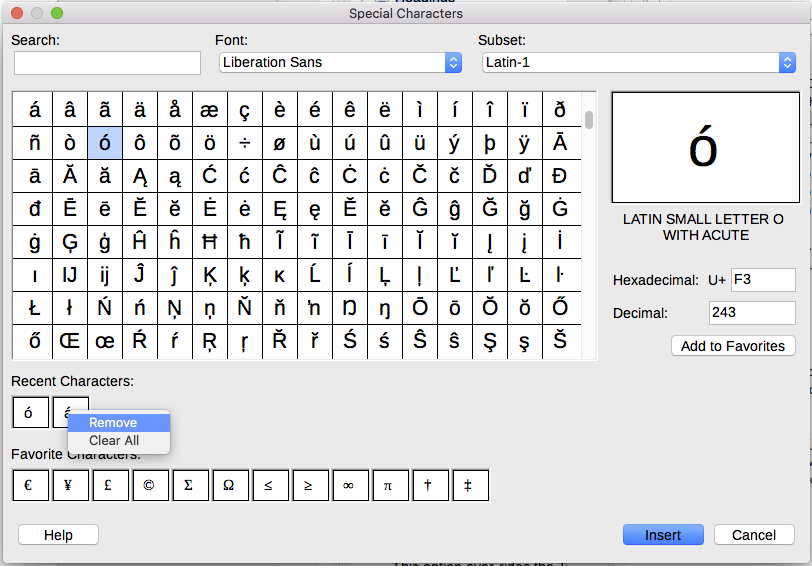
Tips
To view details of a character, single-click it; details are shown on the right, along with its numerical code.
To insert a character and leave the dialog open, double-click the character. To insert a character and close the dialog, click it and then click the Insert button.
Different fonts include different special characters. If you do not find a particular special character you want, try changing the Font selection.
Inserting non-breaking spaces and hyphens
These hyphens and spaces, and more, are also available through Insert > Formatting Mark.
Inserting en and em dashes
To enter en and em dashes as you type, you can use the Replace dashes option on the Options page under Tools > AutoCorrect > AutoCorrect Options. This option replaces two hyphens, under certain conditions, with the corresponding dash.
– is an en-dash; that is, a dash the width of the letter “n” in the font you are using. Type at least one character, a space, one or two hyphens, another space, and at least one more letter. The one or two hyphens will be replaced by an en-dash.
— is an em-dash; that is, a dash the width of the letter “m” in the font you are using. Type at least one character, two hyphens, and at least one more character. The two hyphens will be replaced by an em-dash. Exception: if the characters are numbers, as in a date or time range, the two hyphens are replaced by an en-dash.
In Table 1, the A and B represent text consisting of letters A to Z or digits 0 to 9.
Table 1: Inserting dashes
|
Text that you type |
Result |
|
A - B (A, space, hyphen, space, B) |
A – B (A, space, en dash, space, B) |
|
A -- B (A, space, hyphen, hyphen, space, B) |
A – B (A, space, en dash, space, B) |
|
A--B (A, hyphen, hyphen, B) |
A—B (A, em dash, B) |
|
1--2 (number, hyphen, hyphen, number) |
1–2 (number, en dash, number) |
|
A-B (A, hyphen, B) |
A-B (unchanged) |
|
A -B (A, space, hyphen, B) |
A -B (unchanged) |
|
A --B (A, space, hyphen, hyphen, B) |
A –B (A, space, en dash, B) |
Another means of inserting en and em dashes is through the Insert > Special Characters menu. Select the U+2013 or U+2014 character (found in the General punctuation subset), respectively.
A third method uses keyboard shortcuts. These shortcuts vary depending on your operating system, as described below.
Tip
You can also record macros to insert en and em dashes and assign those macros to unused key combinations, for example Ctrl+Shift+N and Ctrl+Shift+M. For more information about key combinations, see Chapter 20, Customizing Writer.
macOS
Windows
Tip
On a keyboard with no numeric keypad, use a Fn (Function) key combination to type the numbers. (The Fn key is usually to the right of the left-hand Ctrl key on the keyboard.) For example, on a US keyboard layout, the combination for an en dash should be Alt+Fn+mjim and for an em dash it should be Alt+Fn+mjij.
Linux
Tip
The key that operates as a Compose key varies with the Linux distribution. It is usually one of the Alt or Win keys, but may be another key, and should be user-selectable.
Checking spelling and grammar
Spelling
Writer provides a spelling checker, which checks to see if each word in the document is in the installed dictionary. Also provided is a grammar checker within the Spelling dialog, which can be enabled or disabled in the Spelling dialog.
Automatic Spell Checking checks each word as it is typed and displays a wavy red line under any unrecognized words. Right-click an unrecognized word to open a context menu (Figure 9). You can click one of the suggested words to replace the underlined word with the one selected. If the list does not contain the word you want, click Spelling to open a dialog. When the word is corrected, the line disappears. If the word is correct but not in the dictionary, you can chose Add to dictionary to add it.
Figure 9: Spelling context menu
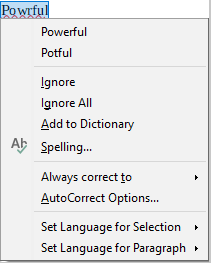
To enable automatic checking, go to Tools on the Menu bar and select Automatic Spell Checking, or click the Automatic Spell Checking icon (which may not be displayed by default) on the Standard Toolbar, or go to Tools > Options > Language Settings > Writing Aids and select Check spelling as you type in the Options list.
If the document has change tracking enabled, then the context menu contains extra options relating to changes in the text.
The choices in the second and third sections of the menu are:
Ignore
Ignore All
Add to Dictionary
Spelling
Always correct to
AutoCorrect Options
In the fourth section of the context menu, you can set language settings for the text. These settings can be applied to the selection, or to the paragraph containing the selection.
Spelling and grammar
To perform a combined spelling and grammar check on the document (or a text selection), select Tools > Spelling or click the Spelling button on the Standard toolbar, or press F7. In order to use this feature, the appropriate dictionaries must be installed.
The Spelling tool checks either the document from the cursor point onwards, or the text selection. It opens the Spelling dialog (Figure 10) if any unrecognized words are found or if any of the built-in grammar rules are broken. You can choose to restart from the beginning of the document when the check reaches the end of the document.
Figure 10: Spelling alert using the Spelling dialog

The elements of the Spelling dialog are as follows.
Text language
Not in dictionary
Suggestions
Ignore Once, Ignore All, and Add to Dictionary
Ignore Rule
Correct
Correct All
Always Correct
Undo
Options
Grammar
By default, Check grammar as you type is enabled in Tools > Options > Language Settings > Writing Aids > Options. Automatic Spell Checking must be enabled for this to work.
If any errors are detected, they are shown underlined by a wavy blue line. Right-clicking on this line brings up a context menu which may be similar to one of those shown in Figure 11.
The first entry in the menu describes the suspected broken grammatical rule.
The second menu item in the left example is Explanations, which opens your browser to a web page offering more information about the error. This entry is not always present in the context menu, as seen in the second example in Figure 11.
Figure 11: Context menu for grammar errors
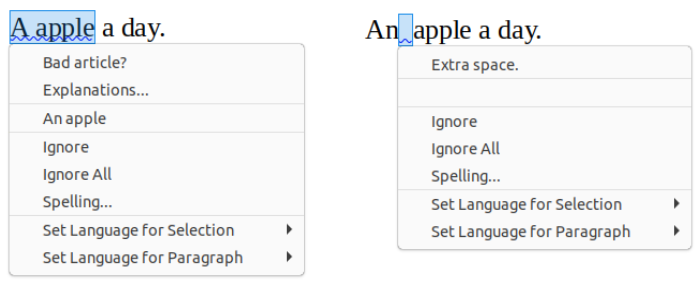
In the second section of the menu is the suggested correction. Clicking this changes the text to the suggestion. The example to the right appears blank, but clicking here removes the extra space causing the error.
In the third section of the menu you can choose to ignore the indicated error, or to open the Spelling and Grammar checker, shown in Figure 12. The example displays the URL that will take you to more information on the error indicated.
In the final section of the menu, you can set the language for the selection or the paragraph.
Figure 12: Dialog showing the URL for expanded explanation
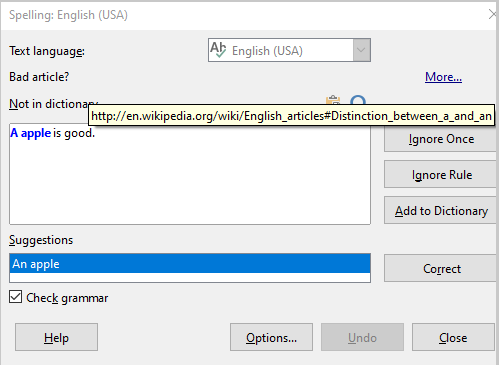
English sentence checking
Additional grammar checking rules can be selected through Tools > Options > Language Settings > English sentence checking, or through Tools > Extension Manager > English spelling dictionaries > Options.
On the English Sentence Checking page, you can choose which items are checked for, reported to you, or converted automatically. Select which of the optional features you wish to check.
After selecting the additional grammar checks, you must restart LibreOffice, or reload the document, for them to take effect.
Figure 13: Additional grammar checking options
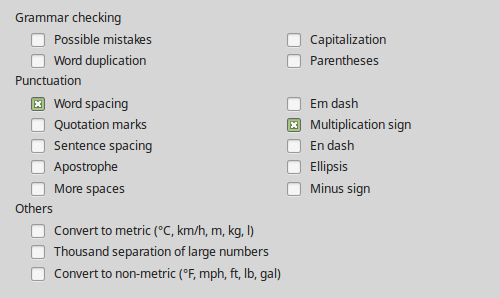
Grammar checking
Possible mistakes
Capitalization
Word duplication
Parentheses
Punctuation
Word spacing
Quotation marks
Sentence spacing
Apostrophe
More spaces
Em dash; En dash
Multiplication sign
Ellipsis
Minus sign
Others
Convert to metric; Convert to non-metric
Thousands separation of large numbers
Using synonyms and the thesaurus
You can access a short list of synonyms from a context menu (Figure 14).
1) Right-click a word and point to Synonyms on the context menu. A submenu of alternative words and phrases is displayed.
2) Click a word or phrase in the submenu to have it replace the highlighted word or phrase in the document.
Figure 14: Synonyms on the context menu
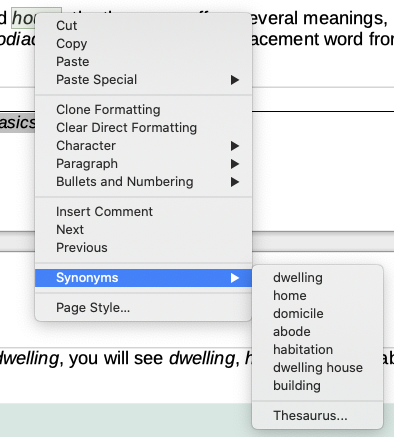
The thesaurus gives a more extensive list of alternative words and phrases. To use the thesaurus:
1) Right-click on a word, point to Synonyms in the context menu, then click Thesaurus in the Synonyms submenu. See Figure 14.
2) In the Thesaurus dialog (shown in Figure 15), click a word or phrase in the list of meanings to select it.
3) Click Replace to make the substitution.
For example, when given the word house, the thesaurus offers several meanings, including dwelling, legislature, sign of the zodiac, and others. Select a replacement word from the list under the relevant meaning, so for dwelling, you will see dwelling, home, domicile, abode, and other alternatives.
Note
If the current language does not have a thesaurus installed, this feature is disabled.
Figure 15: The thesaurus offers alternatives to words

Hyphenating words
You have several choices regarding hyphenation: let Writer do it automatically (using its hyphenation dictionaries), insert conditional (soft) hyphens manually where necessary, or do not hyphenate at all. Each choice has its pros and cons.
Automatic hyphenation
This option over-rides the Tools > Options choices described on the next page.
To turn automatic hyphenation of words on or off:
1) Click the Styles tab on the Sidebar to open the Styles deck. On the Paragraph Styles list, right-click Default Paragraph Style and select Modify (see Figure 16).
2) On the Paragraph Style dialog (Figure 17), select the Text Flow tab.
3) Under Hyphenation, select or deselect the Automatically option.
4) Click OK to save.
Figure 16: Modifying a paragraph style
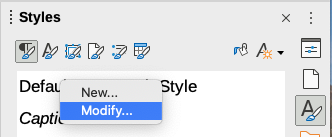
Figure 17: Turning on automatic hyphenation
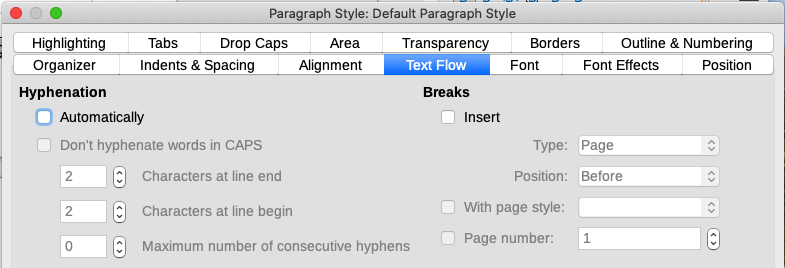
Note
Turning on hyphenation for the Default Style paragraph style affects all other paragraph styles that are based on Default Style. You can individually change other styles so that hyphenation is not active; for example, you might not want headings to be hyphenated. Any styles that are not based on Default Style are not affected. For more on paragraph styles, see Chapters 8 and 9 in this book.
You can set hyphenation settings in Tools > Options > Language Settings > Writing Aids. These choices apply when there is no specific setting in a paragraph style. Hyphenation options set in Writing Aids are effective only if hyphenation is turned on through paragraph styles.
In Options, near the bottom of the dialog, scroll down to find the hyphenation settings.
Figure 18: Setting hyphenation options

To change the minimum number of characters for hyphenation, or the minimum number of characters before or after a line break, select the item, and then click the Edit button in the Options section.
Hyphenate without inquiry
Hyphenate special regions
Manual hyphenation
To manually hyphenate words, do not use a normal hyphen, which will remain visible even if the word is no longer at the end of a line when you add or delete text or change margins or font size. Instead, use a soft hyphen, which is visible only when required.
To insert a soft hyphen inside a word, click where you want the hyphen to appear and press Ctrl+hyphen (minus sign) or use Insert > Formatting Mark > Insert soft Hyphen. The word will be hyphenated at this position when it is at the end of the line, even if automatic hyphenation for this paragraph is switched off.
Using AutoCorrect
Writer’s AutoCorrect function includes a long list of common misspellings and typing errors, which it corrects automatically. For example, “hte” will be changed to “the”. It also includes codes for inserting special characters, emojis, and other symbols.
AutoCorrect is turned on when Writer is installed. You may wish to disable some of its features, modify others, or turn it off completely.
You can add your own corrections or special characters or change those supplied with LibreOffice. Select Tools > AutoCorrect > AutoCorrect Options to open the AutoCorrect dialog. On the Replace tab, you can define what strings of text are corrected and how.
Figure 19: Replace tab of AutoCorrect dialog

To stop Writer replacing a specific spelling, go to the Replace tab, highlight the word pair, and click Delete. To add a new spelling to the list, type it into the Replace and With boxes on the Replace tab, and click New.
To turn AutoCorrect off, uncheck Tools > AutoCorrect > While Typing.
See Chapter 4, Formatting Text: Basics, for discussion of the Options and Localized Options tabs of the dialog.
Using Word Completion
If Word Completion is enabled, Writer tries to guess which word you are typing and offers to complete the word for you. To accept the suggestion, press Enter. Otherwise, continue typing.
To turn off Word Completion, select Tools > AutoCorrect > AutoCorrect Options > Word Completion and deselect Enable word completion.
Figure 20: Customizing word completion
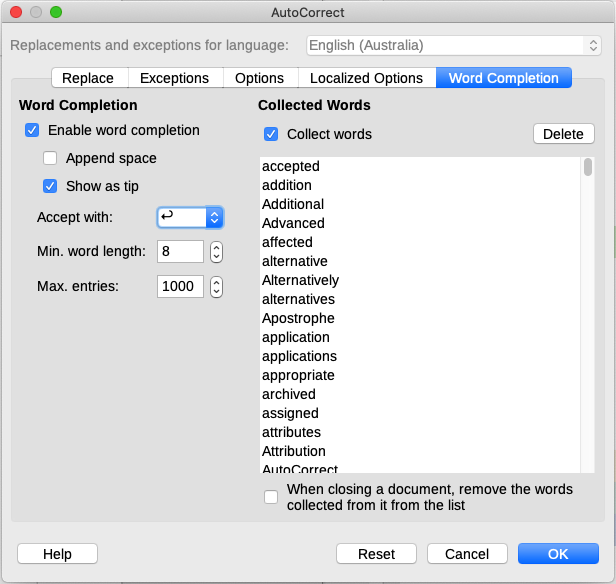
You can customize word completion on the Word Completion page of the AutoCorrect dialog (Figure 20):
-
Add (append) a space automatically after an accepted word.
-
Show the suggested word as a tip (hovering over the word) rather than completing the text as you type.
-
Collect words when working on a document, and then either save them for later use in other documents or select the option to remove them from the list when closing the document.
-
Change the key that accepts a suggested entry; the options are right arrow, End key, Enter (Return), Space bar, and Tab.
-
Change the maximum number of words remembered for word completion and the length of the smallest words to be remembered.
-
Delete specific entries from the word completion list.
Note
Automatic word completion occurs only after you type a word for the second time in a document.
Using AutoText
Use AutoText to store text, tables, fields, graphics, and other items for reuse and assign them to a key combination for easy retrieval. For example, rather than typing “Senior Management” every time you use that phrase, you can set up an AutoText entry to insert those words when you type “sm” and press F3.
AutoText is especially powerful when assigned to fields. See Chapter 17, Fields.
Creating AutoText
To store some text as AutoText:
1) Type the text into your document.
2) Select the text.
3) Go to Tools > AutoText (or press Ctrl+F3).
4) In the AutoText dialog (Figure 21), type a name for the AutoText in the Name box. Writer will suggest a one-letter shortcut, which you can change.
Figure 21: Defining a new AutoText entry

5) Choose the category for the AutoText entry, for example My AutoText.
6) Click the AutoText button at the bottom of the dialog and select from the menu either New (to have the AutoText retain specific formatting, no matter where it is inserted) or New (text only) (to have the AutoText take on the formatting around the insertion point).
7) Click Close to return to your document.
Tip
If the only option under the AutoText button is Import, either you have not entered a name for your AutoText or there is no text selected in the document.
To save a table as AutoText:
1) Create a table and format it the way you want.
2) Select the table.
3) Go to Tools > AutoText (or press Ctrl+F3).
4) Type a name for the AutoText (or amend the suggested shortcut and choose the category for the AutoText entry).
5) Click the AutoText button and select New (because you want the formatting of the table preserved).
6) Click Close to return to your document.
Inserting AutoText
To insert AutoText, type the shortcut and press F3.
Printing a list of AutoText entries
To print a list of AutoText entries:
1) Choose Tools > Macros > Organize Macros > Basic.
2) In the Macro From list, find and expand Gimmicks.
3) Select AutoText and then click Run. A list of the current AutoText entries is generated in a separate text document. You can then print this document.
Figure 22: Basic Macros dialog
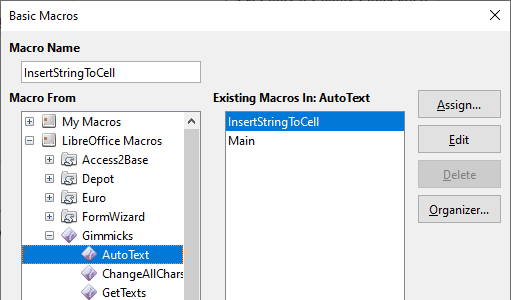
Changing the case of selected text
To quickly change the case of text, select it, choose Format > Text on the Menu bar, and then choose one of the following:
-
UPPERCASE, where all letters are capitalized.
-
lowercase, where no words (except proper nouns) are capitalized.
-
Cycle Case, which cycles the selected words through uppercase, lowercase, and capitalize every word.
-
Sentence case, where only the first word is capitalized (together with any proper nouns).
-
Capitalize Every Word, where every word is capitalized.
-
tOGGLE cASE, which changes every letter to the opposite case.
-
Small capitals, which capitalizes all letters in a reduced font size.
The Format > Text menu also includes several manual formatting options, including bold, italic, and superscript. If Asian language support has been enabled, there are also several options that are used with Asian text: half-width, full-width, Hiragana, and Katakana.
Writer does not have an automated way to do Title Case, where all words are capitalized except for certain subsets defined by rules that are not universally standardized. However, you can use Capitalize Every Word and then restore those words that you do not want capitalized.
You can also change the case of text using the Character dialog or a character style. Choose Format > Character, click the Font Effects tab (Figure 23), then select the type of capitalization in the Effects – Case: box.
Figure 23: Changing the case using the Character dialog
